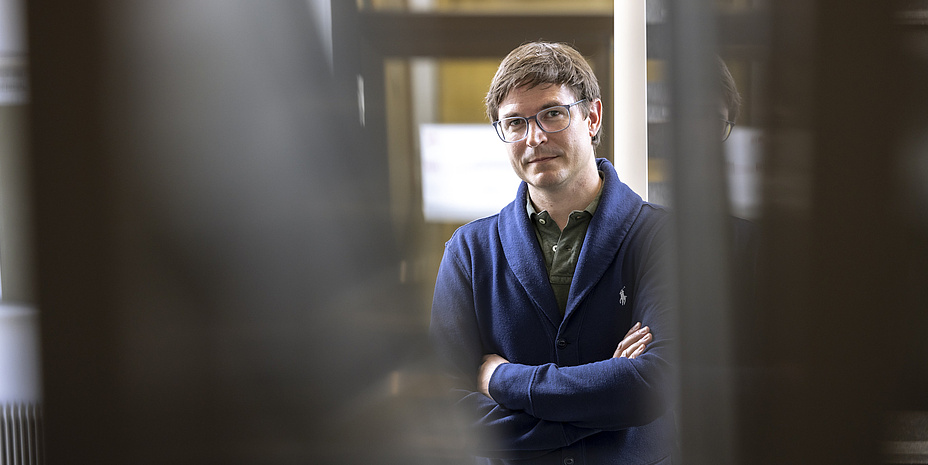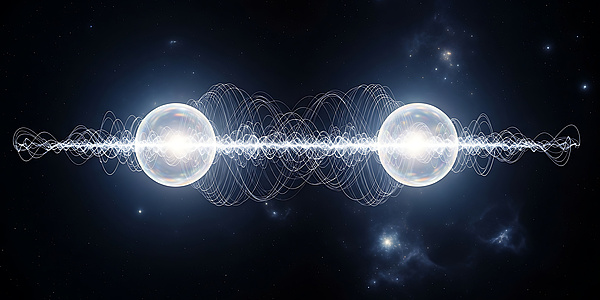“As humans, we have no direct access to the quantum world.”

You have just published a new paper. What’s it about?
Christoph Heil: It’s a collaboration with engineers at MIT, who are working on “superconducting nanowire single-photon detectors”. These are extremely sensitive detectors that sometimes only pick up one photon per day in absolutely dark rooms. However, they have a very low “dark count”, so there are no incorrect measurements due to environmental conditions such as temperature fluctuations.
The detectors consist of a very thin wire made of a superconducting material. Just enough current is sent into this wire so that the superconductivity is not destroyed. When a photon hits the wire, the superconductivity is destroyed at precisely this point and we can measure this.
What was your part in this project?
Heil: We are trying to improve the materials for the nanowires and facilitate their selection. Until now, researchers have used phenomenological models for this purpose, meaning they had to carry out a lot of experiments and materials. Several variable parameters are built into these models and have to be carefully coordinated with each other. We in Graz work with microscopic theories to describe our superconductors and can therefore make much simpler predictions about which materials are suitable or how they need to be improved – without any parameters that need to be adjusted.
However, we not only want to find a suitable material for these applications but also want to refine our models. Above all, the link between our microscopic world and the macroscopic world in which we live is still very difficult to establish. We work on the scale of individual atoms; a detector, for example, consists of millions of billions of atoms.
Are there any other applications for your models apart from the detectors?
Heil: Yes. For example, we could also use them as qubits in quantum devices.
You don’t work in quantum physics yourself, but it has a very big influence on your research work, doesn’t it?
Heil: Without an understanding of quantum physics, none of what I do could be explained or would work at all. The fact that electrons occupy discrete energy states, semiconductor materials have a band gap, etc., forms the basis for LEDs, MRIs and even the definition of our second – almost every aspect of modern technology is based on quantum physics.
Play video
Was an understanding of quantum physics important in order to develop these things, or is quantum physics everywhere because it is simply the basis of our world?
Heil: It is difficult to say what would have happened if we had never developed quantum physics. Of course, certain effects had been seen before. But they weren’t able to be explained. Quantum physics is an extremely effective and successful theory. It makes predictions that can be proved. It is currently the most accurate and best tested theory.
But of course we don’t see the quantum effects in our macroscopic world directly, because they take place on the tiniest of all levels. That’s why the topic often seems detached from reality, wild and inconclusive. But it’s not like that at all, quantum physics is actually very coherent and beautiful. This year (note: 2025), the Nobel Prize was awarded to physicists John Clarke, Michel H. Devoret and John M. Martinis, who designed groundbreaking experiments demonstrating quantum mechanical effects on a macroscopic scale.
Quanta can be in two states at the same time, but a cat cannot be dead and alive at the same time.
(Christoph Heil)
But do we really understand it?
Heil: That depends very much on how we define “understand”. We understand the practical aspects very well. There is a mathematical construct that allows us to make predictions, calculate results and check everything. These predictions match exactly what measurements show us.
But if we mean “understand” from a philosophical point of view, then it becomes difficult. Because, as I said, quantum effects do not manifest themselves in the direct everyday world and as humans, we have no direct access to the quantum world. This can be seen in the Schrödinger’s cat thought experiment. The physicist Schrödinger wanted to show how absurd it is to transfer quantum effects to a macroscopic everyday level. Quanta can be in two states at the same time, but a cat cannot be dead and alive at the same time.
Quantum mechanics is a theory of probability; states superimpose themselves and we can calculate how this system will behave over time. But if you take a measurement now, you suddenly only measure one result. We know this as the “collapse of the wave function”. The fact that something happens so suddenly, that the particle instantly decides in favour of one of the possible states, is something we physicists don’t really like. And for me, why it does this is more a matter for philosophy and metaphysics. But even without a complete philosophical interpretation, we can describe mathematically what happens. And we can use this knowledge in our work in a practical way and visualise it for example numerically with the help of powerful computers.
But if we mean “understand” from a philosophical point of view, then it becomes difficult. Because, as I said, quantum effects do not manifest themselves in the direct everyday world and as humans, we have no direct access to the quantum world.
(Christoph Heil)
But if we don’t fully understand quantum physics, can’t problems arise when we use it to develop important things?
Heil: This question is absolutely justified. But there are two sides to it. We absolutely understand what is happening, we can calculate it very clearly. We have good rules to describe the world in miniature. And these predictions have been confirmed very often. So there is no danger of something happening that we cannot predict in the field of quantum mechanics. This is the practical side, which is very well covered.
What we don’t fully understand is the philosophical side – what the construct of quantum physics means for our understanding of the world.
Of course, we also know that quantum mechanics has its limits as a physical theory and that there are aspects that we may never be able to describe.
Where are the limits?
Heil: Quantum physics describes the smallest building blocks of our world on a microscopic level. In contrast, the theory of relativity – the second important theory of our world – describes the world on a very large scale. It connects space and time, showing that this construct curves and changes. The problem is that we cannot unify these two theories easily. Although there are very promising approaches, they make few verifiable predictions. We may even never be able to verify them experimentally.
Play video
Is that a problem?
Heil: I have a pragmatic approach. In my opinion, this is again more a question of metaphysics or philosophy and not of practical physics. What does a theory actually have to achieve? For me, it has to take us further in our field of research, it has to make verifiable predictions.
Do you understand why esotericists use quantum physics for explanations?
Heil: Our concepts often seem far-fetched and I understand that certain terms can easily be taken out of context. That is the danger of esotericism. When I talk about energy or vibrations, for example, these are measurable physical quantities. They have nothing to do with auras or similar things.
But I understand people’s need to explain things that they can’t explain. This used to be called magic, and quantum physics also often seems to work in a magical way. If you’re not careful, it spills over into esotericism. This is also the case with astrology, for example. In terms of gravitational pull, for example, the position of doctors and midwives has a much greater influence on the baby at birth than the stars in a distant constellation. No charts are constructed from people's movements.
Of course, we don't work with magic, incantations or spells. Quantum mechanics is perhaps the most successful theory we currently have, and it is based on mathematics. I would compare it to grammar, which dictates the rules of language.




